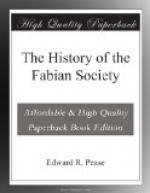In November, 1905, carefully drafted enquiry forms were sent out to all members of the Society except unmarried women, so arranged as to allow exact answers to be given to the questions without disclosure of the name or handwriting of the deponent. Of the 634 posted 460 were returned or accounted for, and only two members signified objection to the enquiry. After deduction of bachelors and others not relevant, we obtained particulars of 316 marriages. I prepared an elaborate statistical report, which showed that in the period 1890-1899 out of 120 marriages only 6 fertile marriages were recorded in which no restriction had been adopted. This was the first and possibly is the only statistical enquiry yet made on the subject, and although the number of cases was minute in proportion to the population, the evidence afforded by that sample was sufficient to be conclusive, that at any rate a cause, and probably the chief cause, of the fall in the birth-rate was voluntary limitation of families.
The method of publication presented some difficulty, and finally it was decided, in order to secure the most generally impressive publicity, to ask Sidney Webb to collect the other available evidence and to make an article out of the whole, to be published over his name. It appeared as two special articles in “The Times” for October 11th and 18th, 1906, and was subsequently reprinted by us as Tract 131, “The Decline of the Birth-rate.”
Other Committees at this period discussed Agriculture, Poor Law, Local Government Areas, Public Control of Electricity, and Feeding of School Children. Reports on all these subjects were issued as tracts, some of which have been mentioned already in connection with their authors, H.W. Macrosty and Hubert Bland, whilst others will be referred to in a future chapter.




